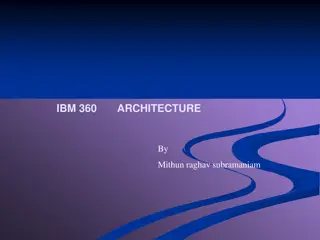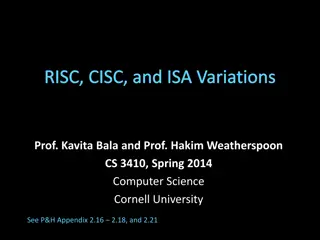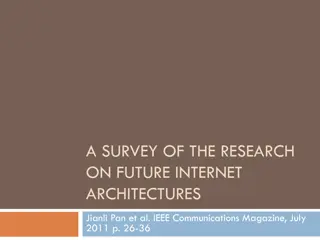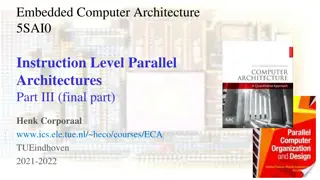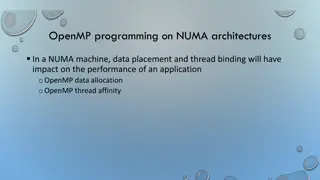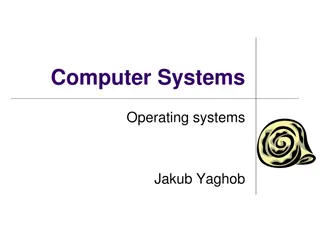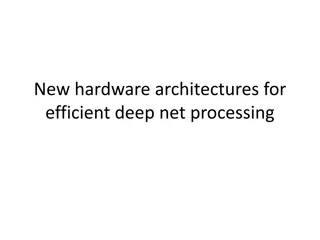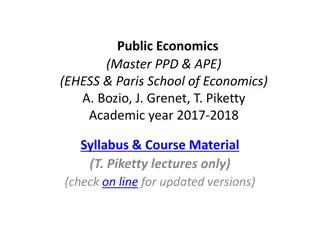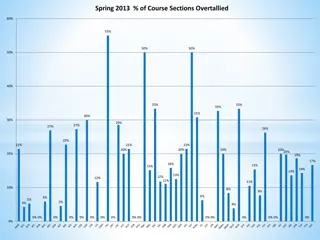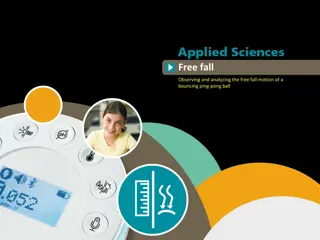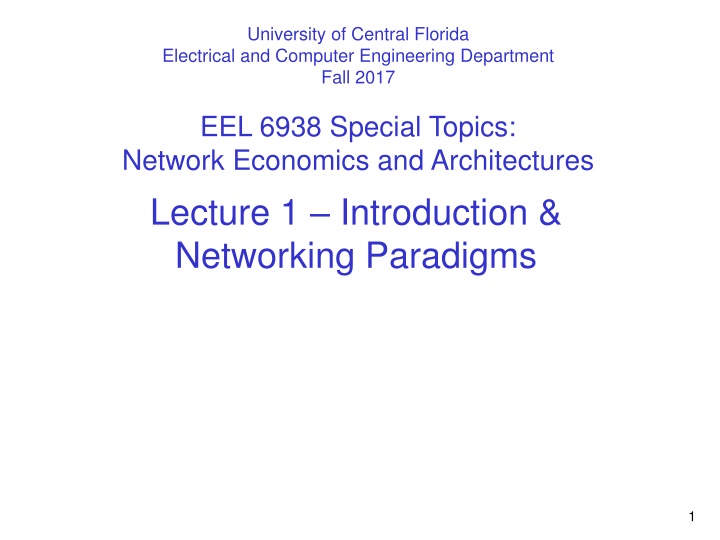
Network Economics and Architectures - Fall 2017 Course Overview
Delve into the principles of internetworking architectures, network economics, and the impact of population effects on network scale. Explore topics such as routing, naming, pricing, and fairness in the context of multi-provider interactions. This course provides a pathway to advanced research in networking through project work and readings, preparing students for a deeper understanding of network evolution and practice.
Download Presentation

Please find below an Image/Link to download the presentation.
The content on the website is provided AS IS for your information and personal use only. It may not be sold, licensed, or shared on other websites without obtaining consent from the author. If you encounter any issues during the download, it is possible that the publisher has removed the file from their server.
You are allowed to download the files provided on this website for personal or commercial use, subject to the condition that they are used lawfully. All files are the property of their respective owners.
The content on the website is provided AS IS for your information and personal use only. It may not be sold, licensed, or shared on other websites without obtaining consent from the author.
E N D
Presentation Transcript
University of Central Florida Electrical and Computer Engineering Department Fall 2017 EEL 6938 Special Topics: Network Economics and Architectures Lecture 1 Introduction & Networking Paradigms 1
Outline Course Outline & Organization Network Architecture Definitions Circuit-switching vs. Packet-switching 2
Course Outline & Organization Instructor Murat Yuksel Phone: (407) 823-4181 Office: HEC 317A Office hours (tentative): Tuesday, 10:30am noon Thursday, 10:30am noon or by appointment Murat.Yuksel@ucf.edu http://www.ece.ucf.edu/~yuksem 3
Course Description & Objectives Principles of internetworking architectures, and their projections on various network protocol elements: routing, naming and addressing function placement and decomposition Implications of network economics on the evolution and practice of network architectures: Networking and population effect and their impact on the scale of the network architectures: power laws, scale-free composition. Multi-provider inter-ISP economics: Pricing, peering, edge-to-edge tussle, neutrality, fairness, and openness. Preparation for advanced research in networking: reading of papers and fundamental perspective project with two architectures and two markets usage of simulators or emulators 4
Prerequisites One of the followings EEL 4781 Computer Communication Networks or equivalent or consent of instructor 5
Textbooks & Other Materials Recommended Textbooks D. Easley and J. Kleinberg. (2010) Networks, Crowds, and Markets: Reasoning About a Highly Connected World. Cambridge University Press. (ISBN: 978-0-521-19533-1) B. Ramamurthy, G. N. Rouskas, and K. M. Sivalingam. (2011) Next-Generation Internet: Architectures and Protocols. Cambridge University Press. (ISBN: 978-0-521-11368-1). Papers, RFCs 6
Syllabus Illustrative list of topics Networking Paradigms Function Placement and Layering Naming and Addressing Internetworking Routing Architecture Pricing, Peering, and Inter-ISP Market Fairness Population Models Structural Models Cryptocurrencies Spectrum Economics 7
Projects and Presentations Project two architectures and two markets start thinking about what to do ASAP individual, no teaming learn to use simulators or emulators for experimentation survey literature on a networking topic: read papers, RFCs, drafts write a report making an insightful discussion of the experimentation and the results obtained Presentations Two per student One for the Related Work of the project One for the Results of the project 8
Network Architecture: Definitions What is an architecture ? the art or practice of designing and building structures and especially habitable ones a unifying or coherent form or structure the manner in which the components of a computer or computer system are organized and integrated www.m-w.com 9
Network Architecture: Definitions What is an architecture ? the art or practice of designing and building structures and especially habitable ones Term Paradigm Architecture Framework Scheme/Protocol ATM Sample 1 Circuit-switching Layered IntServ Sample 2 Packet-switching Layered DiffServ IP Fundamental goal: Effective and useful network connectivity 10
A closer look at network structure: network edge: applications and hosts access networks, physical media: wired, wireless communication links network core: interconnected routers network of networks 11
The network edge: end systems (hosts): run application programs e.g. Web, email at edge of network client/server model client host requests, receives service from always-on server e.g. Web browser/server; email client/server peer-peer model: minimal (or no) use of dedicated servers e.g. Skype, BitTorrent peer-peer client/server 12
Access networks and physical media Q: How to connect end systems to edge router? residential access nets institutional access networks (school, company) mobile access networks Keep in mind: bandwidth (bits per second) of access network? shared or dedicated? 13
The Network Core mesh of interconnected routers the fundamental question: how is data transferred through net? circuit switching: dedicated circuit per call: telephone net packet-switching: data sent thru net in discrete chunks 14
Network Core: Circuit Switching End-end resources reserved for call link bandwidth, switch capacity dedicated resources: no sharing circuit-like (guaranteed) performance call setup required 15
Network Core: Circuit Switching network resources (e.g., bandwidth) divided into pieces pieces allocated to calls resource piece idle if not used by owning call (no sharing) dividing link bandwidth into pieces frequency division time division 16
Circuit Switching: FDM and TDM Example: FDM 4 users frequency time TDM frequency time 17
Numerical example How long does it take to send a file of 640,000 bits from host A to host B over a circuit-switched network? All links are 1.536 Mbps Each link uses TDM with 24 slots/sec 500 msec to establish end-to-end circuit 18
Network Core: Packet Switching resource contention: aggregate resource demand can exceed amount available congestion: packets queue, wait for link use store and forward: packets move one hop at a time Node receives complete packet before forwarding each end-end data stream divided into packets user A, B packets share network resources each packet uses full link bandwidth resources used as needed Bandwidth division into pieces Dedicated allocation Resource reservation 19
Packet Switching: Statistical Multiplexing 100 Mb/s Ethernet C A statistical multiplexing 1.5 Mb/s B queue of packets waiting for output link D E Sequence of A & B packets does not have fixed pattern, bandwidth shared on demand statistical multiplexing. TDM: each host gets same slot in revolving TDM frame. 20
Packet-switching: store-and-forward L R R R takes L/R seconds to transmit (push out) packet of L bits on to link at R bps store and forward: entire packet must arrive at router before it can be transmitted on next link delay = 3L/R (assuming zero propagation delay) Example: L = 7.5 Mbits R = 1.5 Mbps transmission delay = 15 sec 21
Packet switching versus circuit switching Packet switching allows more users to use network! 1 Mb/s link each user: 100 kb/s when active active 10% of time N users circuit-switching: 10 users packet switching: with 35 users, probability > 10 active at same time is less than .0004 1 Mbps link Q: how did we get value 0.0004? 22
Packet switching versus circuit switching Is packet switching a slam dunk winner? great for bursty data resource sharing simpler, no call setup excessive congestion: packet delay and loss protocols needed for reliable data transfer, congestion control Q: How to provide circuit-like behavior? bandwidth guarantees needed for audio/video apps still an unsolved problem Q: human analogies of reserved resources (circuit switching) versus on- demand allocation (packet-switching)? 23
Network Economics: Definitions What is network economics ? business economics that benefit from the network effect. This is when the value of a good or service increases when others buy the same good or service. Wikipedia Market economics of entities that have to both compete and cooperate to make their networks work ISPs of the Internet ISOs of power grid 24
Network Effect Metcalfe: value of an N-node network increases by N2 Is that true? Some suggested N log N We will look at networked markets and their properties.. 25
Compete & Cooperate Don t Cooperate: Your customers do not get to connect Cooperate: Risk of loosing customers The Internet is such a market. We will investigate in details and understand the dynamics of inter-ISP markets. 26
Lecture 1: Summary Network edge access physical media client-server vs. peer-to-peer Internet architecture circuit switching packet switching statistical multiplexing store-and-forward tiered structure network of networks 27
Lecture 1: Reading Roberts, The Evolution of Packet Switching, Proceedings of the IEEE, 1978. Metcalfe and Boggs, ETHERNET: Distributed Packet Switching for Local Area Networks, Communications of the ACM, 1976. 28


